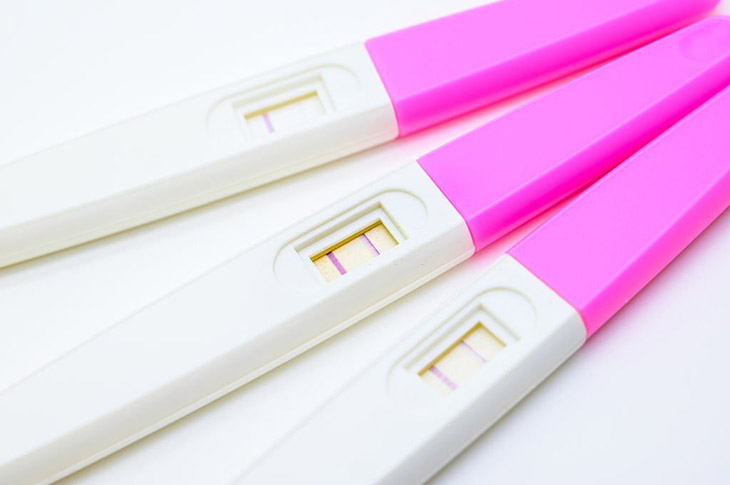When a woman is trying to conceive, she may eagerly take a pregnancy test as soon as possible to check for any signs of pregnancy.
One of the earliest times a pregnancy test can be taken is at 11 days past ovulation (11DPO).
However, a common occurrence for women who take a pregnancy test at this stage is to receive a result with an 11DPO faint line.
This can cause confusion and anxiety, leaving many wondering if they are pregnant or not. This topic will explore the various factors that can cause this pregnancy test problem.
What Causes An 11DPO Faint Line?

Some reasons that can cause an 11DPO faint line on a pregnancy test include low hormone hCG levels, testing too early, using diluted urine, an evaporation line, or a chemical pregnancy.
Early Testing
You may get a faint positive line if you take the test too soon in your pregnancy.
This can result in a faint line as the levels of hCG hormone (human chorionic gonadotropin) may not yet be high enough to be detected by the test.
When done after missing menstruation, pregnancy tests provide the most reliable reading. If the test had been taken before, it could not be as precise.
Not Enough Urine Sample On The Strip
Urine is commonly used for pregnancy tests because it is easy to collect and contains hCG hormone.
This hormone is produced by the placenta after a fertilized egg implants in the uterus.
When a woman is pregnant, hCG levels increase rapidly and can be detected in the urine as early as one week after conception.
A pregnancy test detects the presence of hCG in the urine, indicating that a fertilized egg has implanted and pregnancy has begun.
If there is insufficient pee on the kit test, it cannot provide a correct reading. In this case, you should try again with a new test strip or wait for a better pee sample.
Low HCG Level in The Urine Sample
hCG is a hormone created by the placenta during pregnancy. HCG is released into the mother’s bloodstream after the implantation happening in the uterus.
Its levels will increase rapidly during the early pregnancy stages.
A faint line may indicate that the levels of hCG, the hormone produced by the placenta after implantation, are still too low to be detected by the test.
Medications
Some drugs can also cause false-positive results. These are some examples:
- Certain diuretics
- Antihistamines
- Antipsychotics
Suppose you are taking medication and suspect you’re pregnant; talk to a professional doctor about how it can alter the test results.
How To Interpret An 11 DPO Faint Positive Pregnancy Test?

If you observe a faint line, you could be pregnant, but the test could also be faulty.
In case you’re unsure whether you’re pregnant, you should take another pregnancy test. Here are some cases:
- A faint positive result may indicate a low hCG level. Besides, if the test is taken too early, the level of hCG may be too low to detect, resulting in a faint line.
- Sometimes, a vague line that appears after the test window has passed is actually an evap line, which happens when the urine on the test dries out.
Reading the test within the specified time frame is important to avoid confusion.
To verify a faint positive result, take another test a few days later, using the first-morning urine containing the highest hCG concentration.
If the second test also gives out a faint line, it may indicate very early pregnancy.
Can I Take A Pregnancy Test At 11 DPO?
Yes, it is possible to take a pregnancy test at 11 days past ovulation (11DPO). However, it’s important to remember that taking a test this early may result in a false negative pregnancy.
While some pregnancy tests claim to be able to detect pregnancy at this early stage, it is generally recommended to wait until at least 14 days past ovulation to take a pregnancy test for more accurate results.
Additionally, some women may not experience implantation until later in their cycle, which could delay the rise in hCG levels.
It’s important to be patient and wait until the appropriate time to carry out a test to avoid getting an inaccurate result.
FAQs
Does A Faint Line 11DPO Mean Implantation?
It depends. As mentioned before, various factors can cause a faint line on a pregnancy test, which does not necessarily mean implantation has occurred.
While a faint line on a pregnancy test may be an early indicator of pregnancy, it’s important to confirm with a healthcare provider and follow up with additional testing to ensure accurate results.
What Is The Most Common DPO For BFP?
The most common day for a positive pregnancy test is 14 days past ovulation (DPO) or the day of the expected period.
However, some women may get a positive pregnancy test as early as 11-12 DPO, while others may not get a positive result until several days after their missed period.
It’s important to remember that every woman’s menstrual cycle is different, and the timing of ovulation can vary from cycle to cycle.
This means that the timing of a positive pregnancy test can also vary.
If you suspect you may conceive, it’s best to wait until after your missed period to take a pregnancy test for more accurate results.
Once you continue having concerns or questions about your pregnancy status, consult a healthcare provider for further guidance.
Can You Get A False Negative 11DPO?
Yes, it is possible to get a false negative result on a pregnancy test at 11 days past ovulation (11DPO).
As mentioned, the timing of ovulation can vary from cycle to cycle, and implantation can occur at different times for each woman, affecting the accuracy of a pregnancy test.
Factors such as testing too early or using diluted urine can also contribute to a false negative result.
Conclusion

In conclusion, an 11DPO faint line may indicate a low level of the hormone human chorionic gonadotropin (hCG) produced by the placenta after implantation.
However, a light line can also be caused by other factors, such as testing too early, using diluted urine, or an evaporation line.
In this case, you should try another test after a few days or consult a healthcare provider for further guidance.
